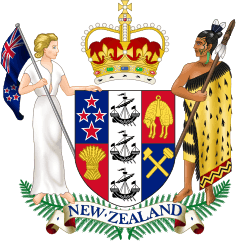Tohunga Suppression Act 1907
| Tohunga Suppression Act 1907 | |
|---|---|
 | |
| New Zealand Parliament | |
| An Act to suppress Tohungas | |
| Date of Royal Assent | 24 September 1907 |
| Date commenced | Immediate |
| Introduced by | James Carroll |
| Amends | |
| None | |
| Related legislation | |
| Maori Councils Act 1900, Quackery Prevention Act 1908 | |
| Status: Repealed | |
The Tohunga Suppression Act 1907 was an Act of the New Zealand Parliament aimed at replacing tohunga as traditional Māori healers with "modern" medicine.
It was introduced by James Carroll who expressed "impatience with what he considered regressive Maori attitudes".[1] Officials had been concerned for years about the sometimes dangerous practices of tohunga.[2][3] Some have claimed[4] that the Act was introduced to target Māori prophet, faith healer and land rights activist Rua Kenana, but it was never used against him.[5]
The Act
The Act contained only four clauses, the first of which simply gave the short title. The second clause stated that "Every person who gathers Maoris around him by practising on their superstition or credulity, or who misleads or attempts to mislead any Maori by professing or pretending to possess supernatural powers in the treatment or cure of any disease, or in the foretelling of future events, or otherwise" was liable for prosecution. The first offence could be subject to a fine of up to 25 pounds or up to six months imprisonment. Subsequent offences could lead to a prison term of up to a year. However, no prosecution under the Act could be commenced without the consent of the Minister of Native Affairs.
The third section enabled the Governor of New Zealand to gazette regulations to enable the intention of the Act to be carried out. The fourth section repealed subsection 5 of section 16 of the Maori Councils Act, which allowed Maori Councils to license tohunga.
Background
Parliament debated the Act. Members portrayed traditional practices in curing smallpox (and other introduced diseases) as ineffectual and sometimes dangerous. This led to characterisations of some tohunga as "charlatans" exploiting their fellow Māori.[6]
Āpirana Ngata supported the Bill, though he said that current tohunga were a bastardized version of the traditional healer. Speakers in favour of the Act referred to "Second-class Tohunga", who did not possess traditional knowledge or authority and just preyed on the superstition of local people.[7] He pointed out that tohunga provided the only medical care available in many districts, and said that the Government would never be able to suppress tohunga unless they could provide a substitute. Hone Heke Ngapua, member of Parliament and great- nephew of the famous Hone Heke, thought that the Bill went in the right direction, but did not go far enough as there was no provision for prosecution of Pākehā tohunga or ‘quacks’[8] (this omission was addressed by the Quackery Prevention Act, 1908).[9]
Effects
Tohunga were the holders of knowledge of most rites, and knowledge in general in wānanga. This included health matters, or rongoā, as tohunga were experts in the use of medicinal plants and herbs. European settlers noted the good health and fitness of Māori when they arrived but the diseases that arrived with them were impervious to traditional healing practices. The perceived loss of power of the tohunga, along with the missionary preachings, led many Māori to accept the new religion of the Pākehā in what was to become yet another destabilising factor to the traditional Māori lifestyle.[10] Many tohunga declined to pass on their oral traditions leaving Māori bereft of much of their traditional base.[11] Whatever the overt intentions, there was a paradigm of the time amongst colonial administrators and the general non-Māori populace that Māori were a "lost race", the effect of banning the practices of spiritual and cultural leaders was that it hastened assimilation.
The Act was repealed by the Maori Welfare Act, 1962.[12]
References
- ↑ "James Carroll". The Te Ara: The Encyclopedia of New Zealand. New Zealand Government. Retrieved 12 April 2017.
- ↑ For example, see Archives New Zealand file ACGS 16211 J1 506/r 1893/1233, 'Hare Matenga, Hariru,Te Ahuahu Date: 9 August 1893 Subject: Regarding treatment of sick natives by Maori Tohunga'.
- ↑ "The Maori superstition in the north" Tuapeka Times, 9 Aug 1893, p. 4.
- ↑ Raeburn Lange et al, cited in "Pruned of its dangers: The Tohunga Suppression Act 1907", by Derek A Dow, Health and history vol 3 no. 1, Maori Health (2001) pp. 41-64
- ↑ "Rongoā – medicinal use of plants", Te Ara
- ↑ Hiroa, Te Rangi "Medicine amongst the Maoris, in ancient and modern times", 1910, p. 109
- ↑ "Rongoa - medicinal use of plants". The Te Ara: The Encyclopedia of New Zealand. New Zealand Government. Retrieved 18 July 2016.
- ↑ Evening Post, 20 July 1907, p. 5
- ↑ "Quackery Prevention Act, 1908". New Zealand Law online.
- ↑ Riley, Murdoch (1994). Maori Healing and Herbal. Paraparaumu, New Zealand: Viking Sevenseas N.Z. Ltd. pp. 7–10. ISBN 0-85467-095-5.
- ↑ "Nga Maumahara: Memory Loss". AUT University. 2011. Retrieved 26 October 2012.
- ↑ "Maori Community Development Act 1962 No 133 (as at 07 July 2010), Public Act – New Zealand Legislation". legislation.govt.nz. 2011. Retrieved 19 June 2011.
Bibliography
External links
- "Tohunga Suppression Act, 1907". New Zealand Law online.
- "Maori Welfare Act, 1962 (see schedule at end)". New Zealand Law online.
- "Rua Kanara Hepetipa". Te Ara (encyclopaedia).
- "Sir James Carroll". Te Ara (encyclopaedia).
- A return to the Tohunga Suppression Act 1907, Māmari Stephens. Victoria University of Wellington Law Review. 2001. "...a fresh analysis..."